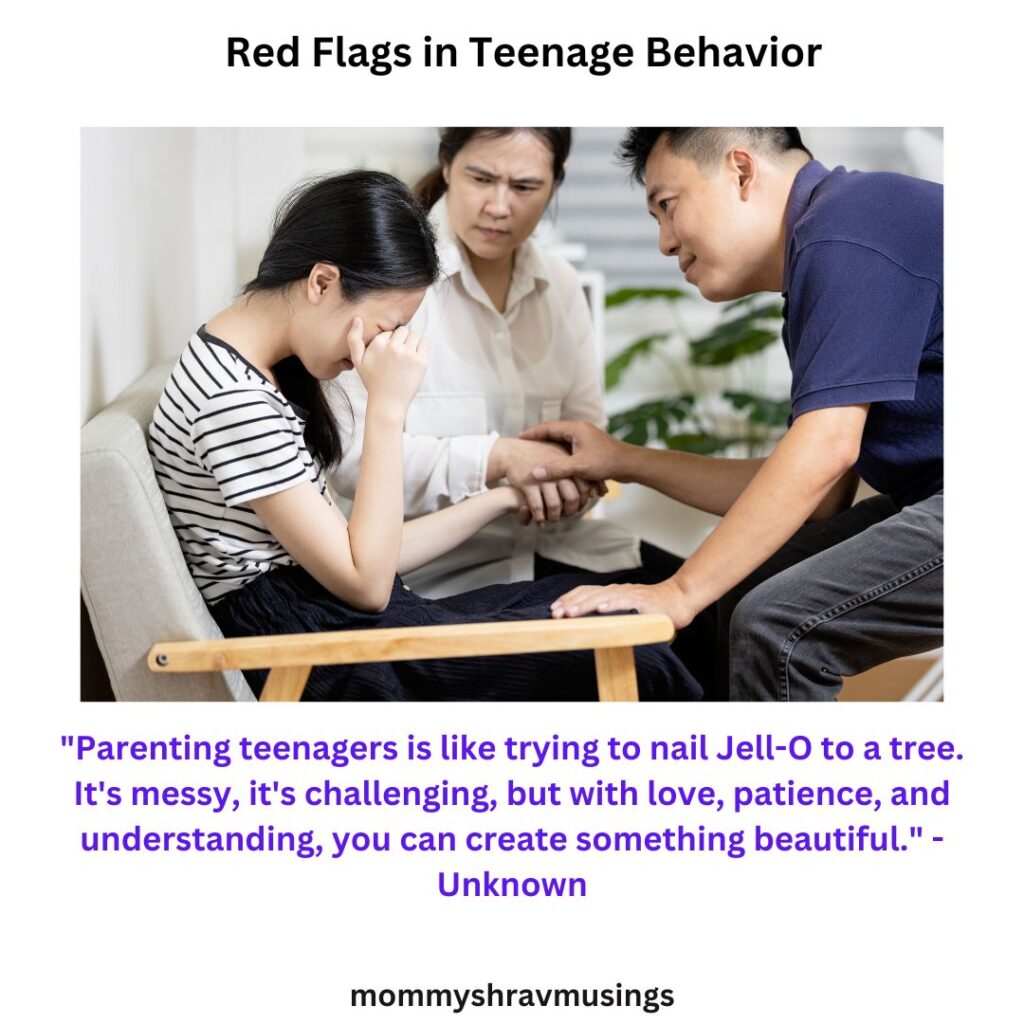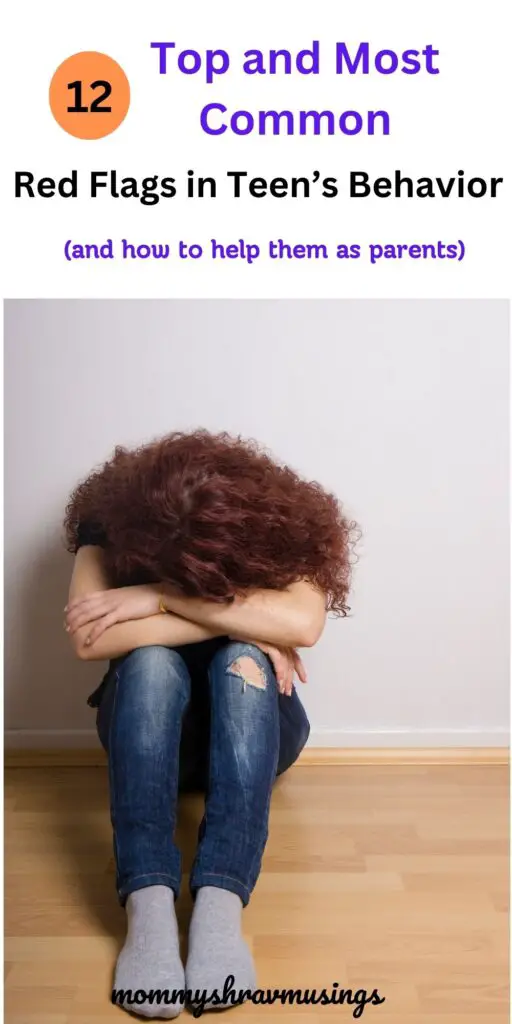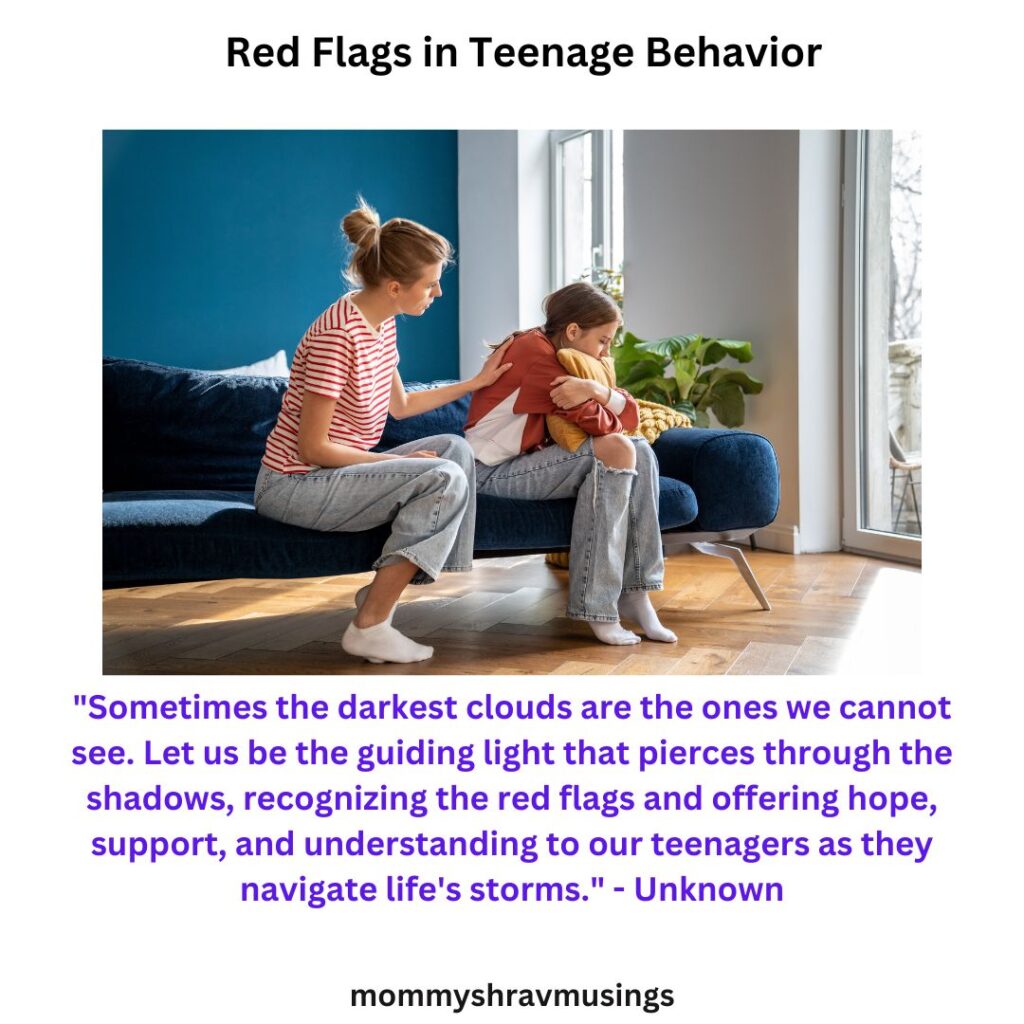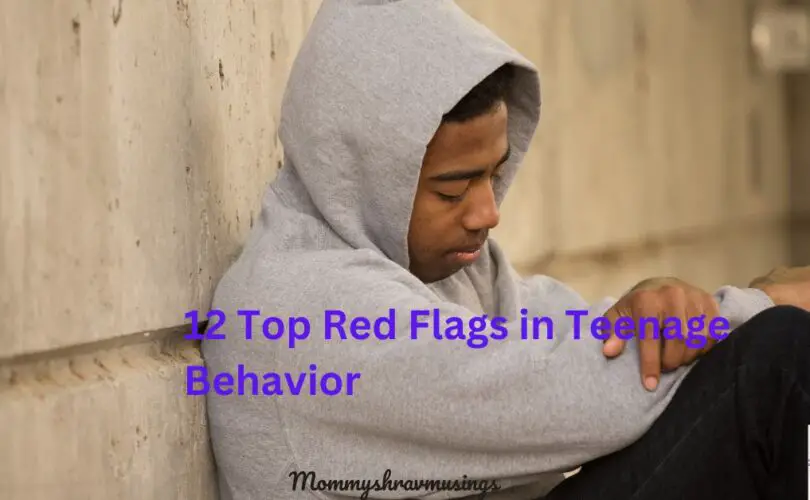12 Top Red Flags in Teenage Behavior that Parents Should be Aware Of.
As parents, we all strive to understand the complexities of our teenagers’ lives, but sometimes deciphering their behaviors can feel like navigating a maze in the dark. Have you ever worried about your teenager’s sudden mood swings, withdrawal from social activities, or academic struggles? You’re not alone. In the current social media-driven world, it has become an essential skill for parents to identify the red flags in teenage behavior that may signal underlying issues that need attention.

Top Red Flags in Teenage Behavior:
Every teenager is unique and may exhibit different behaviors. There are some common red flags that parents can look out for:
1. Sudden Changes in Behavior:
Adolescents are known for their fluctuating moods, but sudden and significant shifts in behavior may indicate that something more serious is going on. Paying attention to these changes and exploring their underlying causes with empathy and support is essential.
2. Drop in Academic Performance:
Academic performance can serve as a window into a teenager’s emotional well-being and overall functioning. A sudden decline in grades without any apparent reason could be a red flag for emotional distress, learning difficulties, or even substance abuse. It’s crucial to address academic struggles promptly and provide appropriate support.
3. Excessive Technology Usage:
Excessive technology use, such as spending hours on social media or gaming, can lead to social withdrawal and isolation from real-life interactions and can be considered another red flag in a teenager’s behavior. Warning signs include anxiety, irritability, and panic when they are not in front of their gadgets.
4. Changes in Social Relationships:
Adolescence is a time of social development, and changes in a teenager’s social relationships can provide valuable insights into their emotional state. Difficulty making or maintaining friendships, sudden shifts in friend groups, or withdrawal from social activities may signal problems with social adjustment, bullying, or underlying emotional issues.
5. Social Isolation:
While some teenagers naturally gravitate towards spending time alone or may need occasional solitude for introspection or recharge, persistent social isolation or withdrawal from social interactions can indicate underlying issues that warrant attention.

6. Mood Swings:
While moodiness is typical during adolescence due to hormonal changes, extreme or rapid mood swings, especially accompanied by signs of depression or anxiety, should not be ignored. It’s essential to recognize the difference between typical mood fluctuations and mood swings that may require professional intervention.
7. Substance Use:
Experimentation with drugs or alcohol is unfortunately not uncommon among teenagers, but excessive or secretive substance use can be a serious concern. Changes in behavior, academic performance, social relationships, or physical appearance may indicate substance abuse, and that needs prompt intervention.
8. Changes in Eating or Sleeping Patterns:
Significant changes in eating habits (such as overeating or undereating) or sleep disturbances can be indicative of emotional distress or mental health issues. Paying attention to these changes and offering support and guidance can help address the underlying issues.
9. Risk-taking Behavior:
Adolescents are known for their propensity for risk-taking behavior, but engaging in reckless activities such as reckless driving, promiscuity, or self-harm may indicate underlying emotional turmoil or a lack of impulse control. Addressing these behaviors with understanding and providing appropriate guidance and support is essential.
Here are some tips to discipline your teen for their bad grades and risky behaviors.
10. Avoidance of Responsibilities:
Persistent avoidance of responsibilities at home, school, or work can signal underlying issues such as depression, anxiety, or substance abuse. Addressing these avoidance behaviors with empathy and support is essential in helping teenagers navigate their responsibilities effectively.
11. Physical Symptoms:
Complaints of frequent headaches, stomachaches, or other physical symptoms without apparent medical cause may be a manifestation of underlying psychological distress. It is essential to take these physical symptoms seriously and explore their potential emotional or psychological causes.
12. Expressing Hopelessness or Despair:
Your teen’s statements indicating a sense of hopelessness, worthlessness, or thoughts of self-harm or suicide should be taken very seriously and addressed immediately. It’s crucial to provide unconditional support and connect teenagers with appropriate mental health resources to ensure their safety and well-being.
By understanding and recognizing these red flags in teenage behavior, parents can provide the necessary support, guidance, and intervention to help their teenagers effectively navigate the challenges of adolescence.

How do we differentiate these red flags from typical teenage behavior?
It’s essential to identify these red flags in teenage behavior at the right time and not confuse them with the typical behavioral problems of teens. And here are those differences:
- While mood swings are common in teenagers, red flags often involve more extreme or persistent changes in behavior, mood, or functioning for longer durations and intense in severity.
- Red flags often interfere with a teenager’s ability to function effectively in various areas of life, such as school, social activities, family relationships, and personal responsibilities.
- Red flags may exhibit consistent patterns or themes across different areas of a teenager’s life, indicating a more significant underlying issue.
- Red flags may be associated with specific risk factors such as substance abuse, self-harm, suicidal ideation, or other risky behaviors.
- Teenagers experiencing red flags may have difficulty responding to typical support or coping mechanisms and may require additional intervention or professional help to address underlying issues effectively.
Overall, while mood swings are a normal part of adolescent development, parents must be vigilant for red flags that may indicate underlying issues requiring support and intervention. By understanding the differences between typical mood swings and concerning behaviors, parents can provide appropriate guidance, support, and resources to help their teenagers navigate the challenges of adolescence effectively.
Underlying Reasons for the Red Flags
Understanding the underlying reasons for these red flags can help parents address the root causes and provide appropriate support to their teenagers. And here are a few potential reasons:
Emotional Distress: A recent study showed that around 21% of teens are undergoing anxiety, depression, and stress-related anxieties.
Peer Pressure: Teenagers undergo tremendous pressure to conform to peer norms, leading them to engage in risky behaviors or adopt unhealthy coping mechanisms
Lack of Family Support: Conflict or dysfunction within the family, such as parental divorce, financial stress, or inadequate communication, can contribute to feelings of insecurity and anxiety.
Trauma or Abuse: Childhood trauma or abuse, whether physical, emotional, or sexual, will have profound effects on a teenager’s mental health and behavior.

Mental Health Disorders: Underlying mental health conditions such as depression, anxiety disorders, bipolar disorder, or attention-deficit/hyperactivity disorder (ADHD) can manifest during adolescence and contribute to changes in behavior, mood, and functioning.
Substance Use or Addiction: Experimentation with drugs or alcohol can quickly escalate into addiction and cause significant harm to a teenager’s mental and physical health.
Social and Cultural Influences: Cultural expectations, societal pressures, discrimination, or stigma related to race, ethnicity, gender, sexuality, or body image can impact a teenager’s self-esteem, identity development, and mental well-being.
Once we can zero in on the underlying reasons for the teen’s behavior, it will be easier for parents to give them the required emotional support to address these changes.
Is your teen a strong-willed young adult, here are tips to connect with them and have a warm bond.
How to Handle the Red Flags in Teen Behavior?
Handling red flags in a teenager’s behavior can be challenging, but there are several strategies parents can employ to provide support and guidance:
- Create a safe and non-judgmental environment where your teenager feels comfortable expressing their thoughts and feelings. Listen actively, validate their emotions, and encourage open dialogue.
- Establish clear expectations and boundaries regarding behavior, responsibilities, and consequences. Consistency is critical to providing structure and stability for your teenager.
- Offer emotional support, encouragement, and reassurance that you are there for them no matter what by offering empathy and understanding towards their issues and feelings.
- Teach your teenager healthy coping skills and stress management techniques, such as mindfulness, relaxation exercises, physical activity, or creative outlets like art or journaling.
- Foster your teenager’s autonomy and independence by involving them in decision-making processes and encouraging them to take on age-appropriate responsibilities.
- Stay involved in your teenager’s life by monitoring their activities, social interactions, and online behavior. Balance supervision with respect for their privacy and autonomy, and be vigilant for signs of risky behavior or potential dangers.
- Model healthy behaviors, communication skills, and coping mechanisms for your teenager to emulate. Demonstrate resilience, problem-solving skills, and self-care practices in your own life.
Remember that parenting a teenager is a journey filled with ups and downs, and it’s okay to seek support from other parents, family members, or support groups when needed. Your love, patience, and support can significantly impact your teenager’s well-being and development.
Are you worried about your Introverted Teens? Here are some tips to guide them through adolescence.
Parting Thoughts:
In conclusion, navigating the complexities of teenage behavior can be challenging. Still, by understanding and recognizing the red flags discussed in this post, parents can better support their teenagers through the ups and downs of adolescence. From sudden changes in behavior to social isolation, each red flag serves as a valuable signal of underlying issues that may require attention and intervention.
Remember, every teenager is unique, and there is no one-size-fits-all approach to parenting. Parents can foster positive relationships, nurture emotional well-being, and guide their teenagers toward a brighter future by approaching teenage behavior with empathy, understanding, and patience.
QOTD: Ask your teenager – what is their most appreciated way of supporting them that makes them feel happy and confident.

Suhasini, IP, is the Author of the book “Practical Tips for Kids Mental Health.” As a certified kids and parents life coach, she helps/guides you toward a happy family life for your kids. She firmly believes that “Emotionally Happy Kids of today are the Mentally Strong and Happy Citizens of tomorrow.” Let’s make the world a happy and beautiful place for our kids to thrive.








[…] Are you worried whether your teen’s behavior is normal or not? Here are some red flags that you need to be aware of in your teen’s behavior. […]